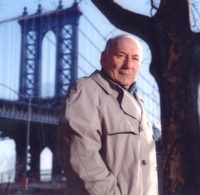Bridge Designer Buckland & Taylor Founders Retire

Peter Taylor and Peter Buckland founded their titular firm in Canada. Photo courtesy of COWI
In 1969, a newly minted bridge designer, Peter Taylor, met the head of a wind-tunnel testing lab in Ottawa, Ontario. Bob Wardlaw also knew another young bridge engineer named Peter Buckland. He suggested that they meet.
The duo went on to form the notable firm Buckland & Taylor, now a COWI subsidiary, which worked on the Alex Frazier bridge, the Lion’s Gate Bridge, the Ravenel Bridge and the Rion-Antirion Bridge, the new New York Bridge, the Milton-Madison Bridge replacement and scores of others.
“I guess I was a matchmaker,” says Wardlaw.
2015 saw the end of an era in bridge design, as both Peters retired. “I feel very complete. I’ve had a fantastic career. I couldn’t ask for better, and it’s done,” says Buckland.
Taylor was designing a cable-stayed bridge in Montreal when he met Buckland and joined his team working on a third crossing in Vancouver. Soon after, the provincial highway department asked the duo to look at redecking the Lion’s Gate Bridge.
“We formed our company right there and then,” says Taylor. The duo came up with the concept of an orthotropic steel deck for the viaduct portion and then moved on to replacement of the main deck with a jacking traveler suspended from hangers over each deck section to be removed.
COWI acquired the firm in 1998.
Buckland notes the advancements in understanding seismic issues, using alternative project delivery and the evolution of anti-corrosion materials. Taylor adds, “We were fortunate in our timing. When we came out of school in 1960, we were on the threshold of a huge revolution in the way bridges were structured, build and analyzed.” As late as 1964, the Port Mann Bridge’s 1,200-ft-arch structure was designed by hand, he recalls. “When the time came to erect that bridge two years later, we were using computers to analyze the main span closure and tiebacks.”
Both also cite the advancement of design-build as an advantage for the firm. “We had always worked with the contractor anyway on erection engineering,” says Buckland. “The Confederation Bridge was an early example of design-build, and we learned a lot.”
That knowledge helped drive the successful completion of the Ravenel Bridge in Charleston, S.C., adds Taylor. “That was a simple design-build. Since then, it’s become more complex. Everyone’s jumping on the bandwagon … piling on layers of bureaucracy.”
Not that it’s a concern for the newly retired duo. “I’ve had a wonderful career beyond my wildest dreams,” says Taylor. “I’d like to read more books. I’m sailing to Tahiti. I won’t be looking over my shoulder at someone else’s deadline.”





